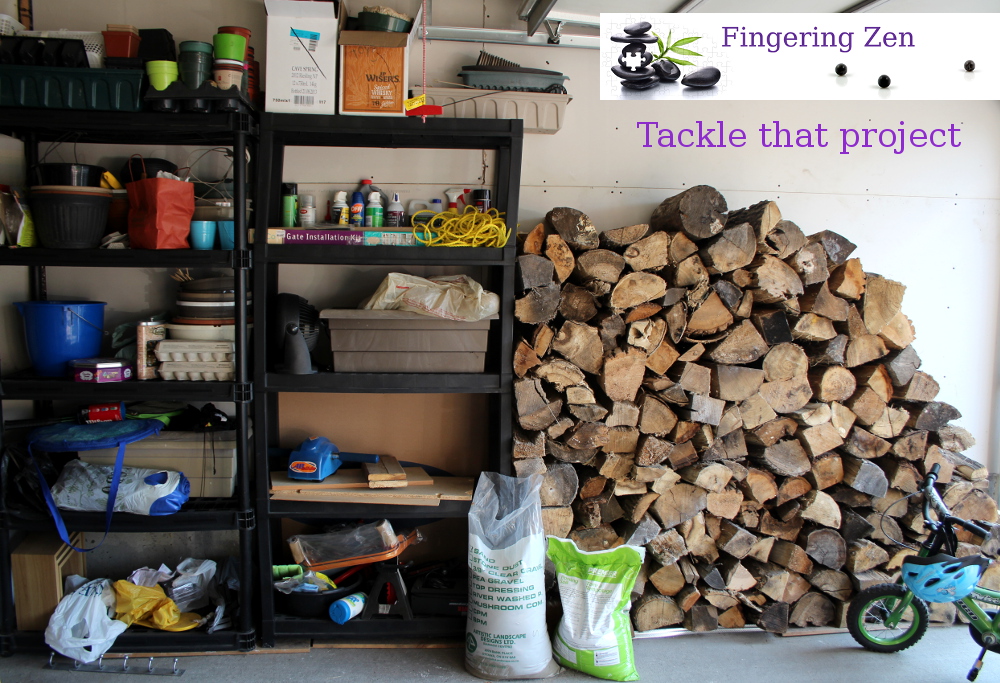When we have a large project on our mind, we often make it out to be more intimidating than it is. We think it is harder, more complicated, and will take a lot of time. We wait for that “right” day when we have 8 hours without interruption to even tackle the planning of it. As a result, the project gets postponed indefinitely. We end up procrastinating, instead of studying for an exam, executing a work project, completing a home improvement.
All you need is a short planning session and the right attitude. You’ll be surprised how soon you can cross it off your to-do list. This weekend, in 3 hours, we have tackled the garage organization — a project that some people are dreading for months.

When we were preparing to move, many people have said that months or years after their own move they are still “living in boxes” or have many boxes still unopened. They prophesied that we shall not be settled for months. I refused to accept that as a given, and so far we have made great strides towards being comfortable and productive in our new home. My goal is to have all large projects completed before winter. It has now been 3 months, and this is what we have accomplished so far:
- Our place has gone through a large renovations project (ripping out all carpets and replacing them with hardwood), which did include external contractors and required a lot of coordination and some material sourcing on our part.
- We have unpacked all the boxes from the move, so we now know where everything is.
- We have organized all the living spaces efficiently, including children’s clothes and an effective workspace.
- We have washed all windows (inside and out), baseboards, floors, cabinets, and dusted all the walls and ceilings. I have washed more windows this summer than I have in the past 20 years.
- We have had a full-house water filter, a drinking water filtration system, and a central vac installed.
- We got the ducts cleaned (oh my, they had so much construction dust and debree!)
- We have a lovely blooming and fruitful garden, including a permaculture herb spiral, which got planted in 2-3 weeks after we moved in.
Through all this, we have been spending lots of time working outside of home, playing with the kids, inside and outdoors, eating healthy meals (most of the time), entertaining guests, and hosting a housewarming.
Of course, there are other projects we would like to undertake in the future to make the place more suited to our needs, more aesthetically pleasing, more comfortable. This, naturally, will take more time and planning. But as long as we approach it without being overwhelmed, they will all be completed and not cause excessive stress.
Here is how we do it:
Step 1 – Plan execution steps and resources.
Identify the smaller tasks that comprise the project. In the case of small projects, this could be 2 or 3 tasks. In the case of larger projects with steps depending on completion of previous steps, it requires more careful planning. For each task, identify the time, the materials (if any) and the help it would take to do. The more you think the project through at this stage, the easier executing it will be. However, don’t get bogged down in details or trying to make a perfect decision. You might end up researching until you are blue in the face and unable to decide between alternatives that some praise and others condemn. Research enough to make a decision that makes sense to you.
For the garage organization project, we have planned the following steps:
- Move all the items that shall not stay in the garage to the basement. Most of the items we use day-to-day are already occupying their appropriate places in the house. The basement has been designated as the storage area for more delicate things that cannot survive the garage or those that will need to be more accessible in winter. This would only need us to identify these items and move them. Easily done with 2 people and about 15 minutes.
- Remaining items would occupy shelving units. We had two already completed and placed and two more waiting in the middle of the garage. Our biggest obstacle was a large pile of firewood, taking up space all along one garage wall, where the shelving units would need to reside. This step needed us to plan where the shelving units would go and decide what to do with the firewood. The discussion and decision took about 5 minutes.
- We knew that to organize the items piled on the floor, we would have to put up the shelving units along the wall, for which we would need to move the firewood out of the way. The firewood would then need to be stacked higher in the smaller space next to the shelves. The biggest undertaking appeared to be moving the firewood away from the wall and then stacking it back. This seemed so daunting that we were tempted to keep putting this off, our biggest challenge being that when we are both home, both our children are home as well. They rarely nap at the same time these days and having either of them in the garage while we clean, among various unsafe items, would not have been possible. Thus we needed an awesome nap time (unlikely) that would give us 2-3 uninterrupted hours, or someone to watch the children while we were working. We knew the time, we knew the execution plan, we needed child-minding help.
Step 2 – Acquire materials.
Source what you need to complete the project. This might include assembling existing items, renting, borrowing, or purchasing equipment and supplies, finding knowledgeable people to advise or help you. Breathe deeply, don’t get overwhelmed with lots of things that are needed. Tackle them one task at a time — plan what is needed for each step and find out where to get it. For our garage organizing project, we had to assemble the shelving units. The rest was just physical work to be done.
Don’t stress the small stuff – you can tweak the details as you go. For instance, we didn’t know what we shall place under the newly stacked firewood to prevent it from getting wet. The existing rails appeared too long to work with the shelves in place. Once we have removed all the firewood from its original place, we have discovered that we can reuse some of the shorter metal rails that were buried under the pile.
Step 3 – Think in terms of the time that is available to you.
We took up the first two steps (moving away items that obviously did not belong in the garage and deciding on the placement of the shelves and firewood) when we had 5-10 minutes of quiet time here and there. Don’t underestimate the power of short time intervals. Clearing away extraneous items before you get started on any project will help you focus better in the field of work that remains.
Step 4 – Seize the opportune moment.
My mother was coming to visit from out of town for a couple of weeks at the end of summer, and this was the opportunity for having 3 adults, one of whom could watch the children and the other two take care of the physical labour. We have spent the morning playing with the kids and taking them on a grocery shopping adventure, which resulted in two tired, happy children who gratefully went down for a nap after all the excitement.
My partner went to run a couple of errands, while my mother and I proceeded to clean the shelving units, move the firewood away from the wall, and sweep the floor. By the time he got back, the wall was clear and ready for everything to be organized. We proceeded to place the shelving units and to organize: more frequently used items were placed in locations closer to the inner door, and less frequently or seasonally used items (such as car maintenance and gardening supplies) were put on the newly-placed shelves.
Afterwards, we have re-stacked the firewood, and were in the last stages of clean-up when the children woke up, so my mother went in to play with them. My partner and I then spent about 20 minutes sorting through a few remaining boxes and deciding what goes into the house, what stays in the garage, and what needs to be laundered. It then took him another 10 minutes or so to shuffle things to where they needed to be, while I joined my mother in taking care of the kids.
Step 5 – Celebrate.
Make it into a social occasion and combine activities for added benefit. We ended up spending lots of time with the children during the day, and had a good workout session while socializing with my mother. In the morning, we marinated some shrimp and chicken, so, after the garage project, we had a lovely afternoon in the garden, making some kebabs, and collecting greens, herbs, and cucumbers for a salad, all of which was then gladly consumed by everyone.
As the above example clearly shows, it is difficult to do certain things without external help. If you, like us, don’t have family help readily available, you can either plan for when the family is visiting or find a way to get help. I have recently come across a brilliant arrangement mentioned by Katy Bowman in her Community podcast episode: rotating time with families helping each other around the house. The idea is that, say, four families (usually including children) agree to help each other. First weekend, everyone gets together at the first family’s house and helps them do whatever needs done: cleaning, cooking, organizing, planting a garden, renovating, etc. In the meantime, one of the adults (or two, if you want to make it more social) is watching the children. People can switch up, as long as everyone is contributing to completing whatever tasks need doing. Everyone brings a dish or two, so that the afternoon can end in a potluck, to celebrate the completion of the work. Next week, the four families repeat this in the second family’s home, doing whatever needs doing there. The next two weekends, the remaining two families get help. Work goes faster with more hands, you have a variety of skills at your disposal, people are socializing, children are playing together in a new house (which, as everyone knows, is way more fun than the same house day after day), and everything gets accomplished. I’d love to try this arrangement out.
I confess, I’m guilty of having 2-3 projects on the go at any given time. It is handy to overlap material sourcing stage of one with the planning stage of another, for instance, but it is much easier to focus on one project at a time, especially if you tend to get very stressed out or have limited time intervals due to other endeavors.
This post has become rather long, as I really wanted to illustrate each point well. Don’t be afraid to tackle larger projects. To get to an organized garage, all we needed to do was plan the steps and resources needed to complete them (time, materials, people), do whatever prep work we could in shorter time intervals available to us, execute the most complex step when all the resources were available, and celebrate the project completion.
Make it fun and don’t forget to celebrate. The success of one project will inspire you to tackle the next one. It’s not as hard as you imagine. You can do it!










